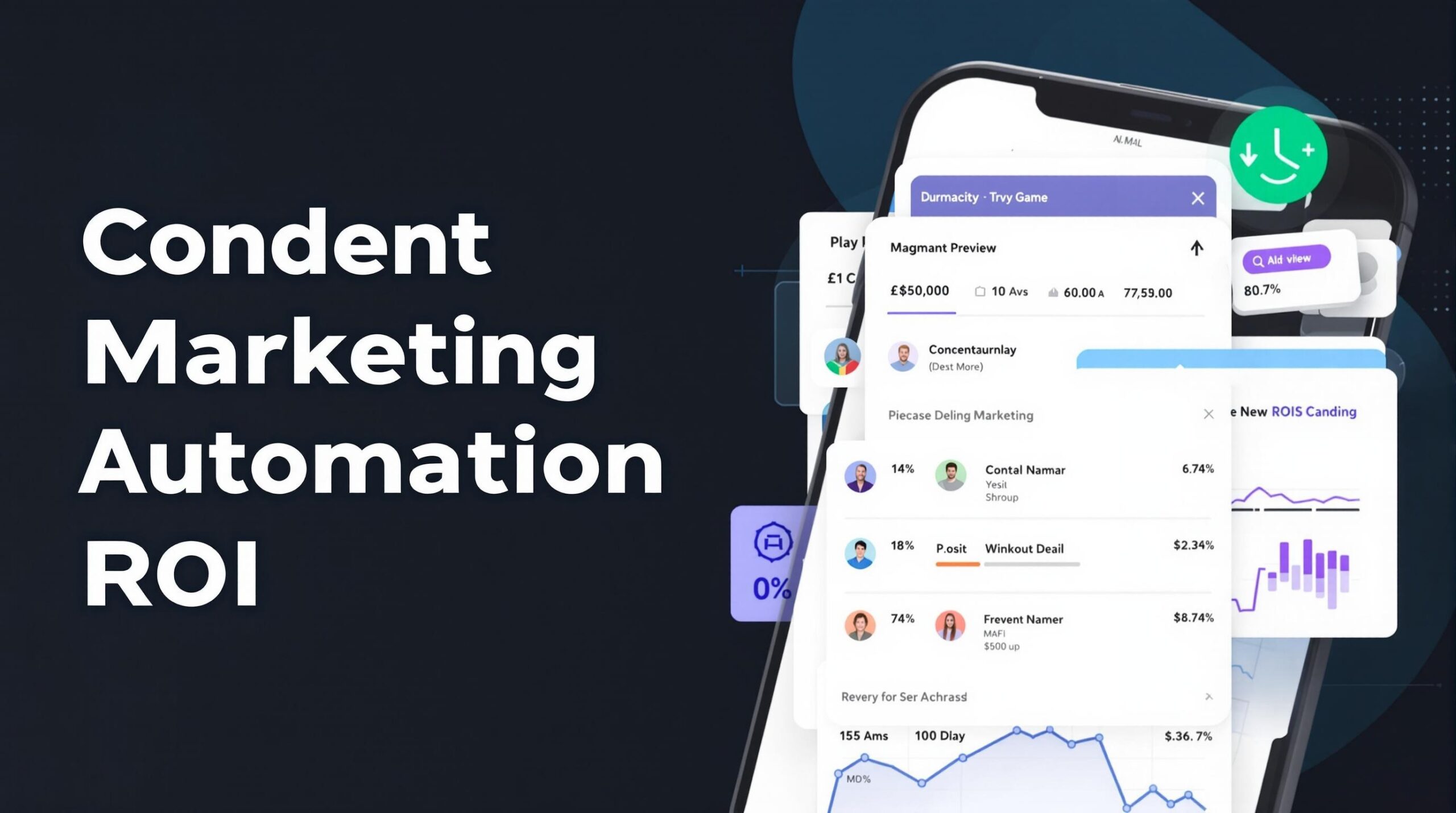How to Measure ROI on Content Automation
Content automation can transform your marketing efforts from resource-intensive manual processes into streamlined, efficient operations that deliver measurable business impact. By implementing the right measurement framework, businesses can accurately track and optimize their content automation ROI, with top performers achieving returns of up to 544% through enhanced personalization and workflow efficiency.
Key Takeaways
- Companies using marketing automation see 107% better lead conversion rates compared to non-users
- Every $1 spent on automation generates $8.71 in return on average
- 76% of companies achieve positive ROI within 12 months of implementing content automation
- Automated workflows can recover 15-20 hours per week of productive time for marketing teams
- Proper multi-touch attribution models are essential for accurate ROI measurement
The True Value of Content Automation: An Overview
The numbers don’t lie when it comes to content automation ROI. According to Aberdeen Group research, businesses that implement marketing automation experience 107% better lead conversion rates compared to those still relying on manual processes. This dramatic improvement isn’t just coincidental – it represents the tangible business impact that comes from delivering the right content to the right audience at the right time.
The financial returns are equally impressive. Nucleus Research found that for every dollar invested in automation technology, businesses generate an average return of $8.71. This exceptional return makes content automation one of the highest-yielding marketing investments available today.
The impact extends beyond just leads and sales. Teams that embrace automation tools and strategies typically recover between 15-20 hours per week that would otherwise be spent on repetitive tasks like content scheduling, distribution, and performance reporting. This productivity gain allows marketing teams to focus on higher-value creative and strategic work.

Essential ROI Metrics Every Business Should Track
To properly measure your content automation ROI, I need to focus on several key performance indicators that directly reflect business impact. The most important metrics include:
Conversion Rate: This fundamental metric shows how effectively your automated content turns prospects into customers. InRiver’s study demonstrated a remarkable 451% increase in qualified leads for businesses that implemented content automation. By tracking pre-automation and post-automation conversion rates, you can clearly demonstrate value.
Customer Acquisition Cost (CAC): Automation reduces the manual effort needed to acquire new customers. By tracking how much you spend to gain each new customer before and after implementing automation, you can quantify the efficiency improvements in real dollars.
Customer Lifetime Value (CLV): Automated personalization increases how much customers spend over time. A simple CLV calculation involves multiplying annual customer spend by retention period. For example, a customer spending $1,000 annually with a 2-year average retention equals a $2,000 CLV.
Return on Ad Spend (ROAS): According to Digitalsilk, businesses achieve $5.44 in revenue for every $1 spent on automated campaigns. This 544% return represents the power of precisely targeted content delivered through automated systems.
Productivity Gains: DivvyHQ reports that marketing teams recover 15-20 hours weekly through workflow automation. These time savings directly translate to reduced overhead costs or increased output with the same resources.
Step-by-Step ROI Calculation Framework
Calculating content automation ROI requires a systematic approach that accounts for both costs and returns. I recommend using this formula:
ROI = [(Revenue from Automation – Investment Cost) / Investment Cost] × 100
Let’s apply this to a practical example: If your business invests $50,000 in content automation tools and processes, and this generates $100,000 in attributable revenue, your ROI calculation would be:
ROI = [($100,000 – $50,000) / $50,000] × 100 = 100%
When calculating investment costs, be sure to include:
- Content creation tools and subscriptions
- Team training and implementation time
- Ongoing software and maintenance fees
- Distribution and promotion expenses
For revenue attribution, you’ll need to track several key metrics:
- Direct sales from automated campaigns
- Lead conversions through automated nurture sequences
- Organic traffic growth from automated content distribution
- Time savings multiplied by hourly team costs
Forrester’s research shows that businesses using automation technology see 25% higher revenue compared to those that don’t. This benchmark can help set realistic expectations for your ROI projections.
Tools That Simplify ROI Tracking
The right tools can make ROI measurement significantly easier and more accurate. Depending on your business size and needs, I recommend considering these options:
Workflow Automation Platforms: DivvyHQ offers templates and task assignments that streamline content creation, while Sitecore provides robust analytics for tracking CLV and other advanced metrics. These platforms create a central repository for all content-related data, making attribution much simpler.
Analytics Solutions: Google Analytics remains essential for tracking traffic and conversion metrics, while platforms like Marketo offer more sophisticated campaign performance insights. The key is connecting these analytics tools with your automation platforms to create a complete data picture.
AI-Enhanced Solutions: Platforms like Salesforce leverage artificial intelligence to boost marketing ROI by approximately 25%. These tools can identify patterns and opportunities that human analysis might miss.
For small businesses, I recommend starting with user-friendly tools like DivvyHQ with its drag-and-drop calendars and straightforward analytics. Enterprise organizations will benefit more from comprehensive solutions like Salesforce that offer predictive analytics and cross-channel attribution.
Many of these platforms integrate with the best content automation tools available today, creating a seamless ecosystem for both execution and measurement.
Real-World Success Stories
Theory is helpful, but seeing actual results can be even more compelling. Company X successfully reduced manual content tasks by 40% through automation, achieving what they described as “significant ROI” through their content creation system. Their approach focused on automating repetitive tasks while keeping human creativity at the center of their strategy.
Gilt Groupe provides another excellent example, increasing their email campaign revenue by 12% by implementing behavior-based segmentation through their automation platform. This improvement came from delivering more relevant content to subscribers based on their previous interactions.
These results aren’t outliers. VB Insight’s industry study found an average ROI of 77% across businesses implementing content automation. Meanwhile, Marketo users report an impressive 76% revenue growth within the first year of implementation.
The common thread among these success stories is a methodical approach to implementation combined with careful measurement of both costs and returns. By comparing automation versus manual creation, these companies were able to clearly demonstrate the value of their investments.
Overcoming Common ROI Measurement Challenges
Measuring content automation ROI isn’t without its challenges. According to industry research, 63% of marketers struggle to link revenue directly to specific content pieces. This attribution problem becomes even more complex when customers interact with multiple content touchpoints before converting.
The solution is implementing multi-touch attribution models that give appropriate credit to each content piece in the customer journey. This approach requires more sophisticated tracking but provides a much more accurate picture of content performance.
Integration costs can also pose a challenge when implementing automation tools. To mitigate this issue, I recommend prioritizing high-impact tasks like publishing and lead nurturing for initial automation, then expanding as ROI is proven.
Invoca’s framework for setting SMART goals (Specific, Measurable, Achievable, Relevant, Time-bound) provides an excellent structure for phased implementation. This approach ensures you don’t try to automate everything at once, which can lead to poor execution and incomplete measurement.
Centralized dashboards from platforms like Sitecore and DivvyHQ can help overcome data fragmentation by pulling metrics from multiple sources into a single view. This consolidation makes it much easier to attribute revenue to specific automated workflows.
Future Trends Shaping Content Automation ROI
The content automation landscape continues to evolve rapidly, with several emerging trends set to impact ROI measurement. Currently, about 40% of businesses automate approximately 10% of their content tasks using AI, but this percentage is growing exponentially.
Hyper-personalization represents one of the most promising developments, with 39% of marketers citing AI-driven personalization as the top trend in email marketing. As personalization technology improves, we can expect even higher conversion rates and customer engagement from automated content.
Looking ahead, AI adoption is predicted to reduce Customer Acquisition Costs by 15-20% by 2025, creating even stronger ROI potential. Digitalsilk forecasts a $107 billion market for AI in marketing, indicating substantial investment and innovation in this space.
These trends point toward automation becoming not just a competitive advantage but a basic requirement for effective content marketing. Businesses that measure and optimize their automation ROI now will be better positioned to leverage these emerging technologies as they mature.
Implementing Your ROI Measurement Strategy
To start measuring your content automation ROI effectively, I recommend following these steps:
First, establish your baseline metrics before implementing automation. Document current conversion rates, productivity levels, and content-related costs to provide a clear comparison point for measuring improvements.
Next, select appropriate tools based on your business size and content needs. Small businesses might start with Google Analytics plus a basic automation platform, while enterprises will benefit from more comprehensive solutions.
Implement a phased approach by starting with high-impact automation tasks first. Content distribution, email nurture sequences, and social media posting often provide the quickest ROI and can help build momentum for further automation.
Set realistic timelines for evaluating performance. While some businesses see ROI within 30 days, most (76%) achieve positive returns within 12 months. Patience and consistent measurement are essential for accurate assessment.
Finally, implement multi-touch attribution to capture the full value of your content across the entire customer journey. This approach ensures you don’t undervalue content that plays a crucial role in nurturing leads, even if it isn’t the final conversion point.
By following this structured approach to ROI measurement, you’ll not only justify your current automation investments but also identify opportunities for further optimization and expansion.








